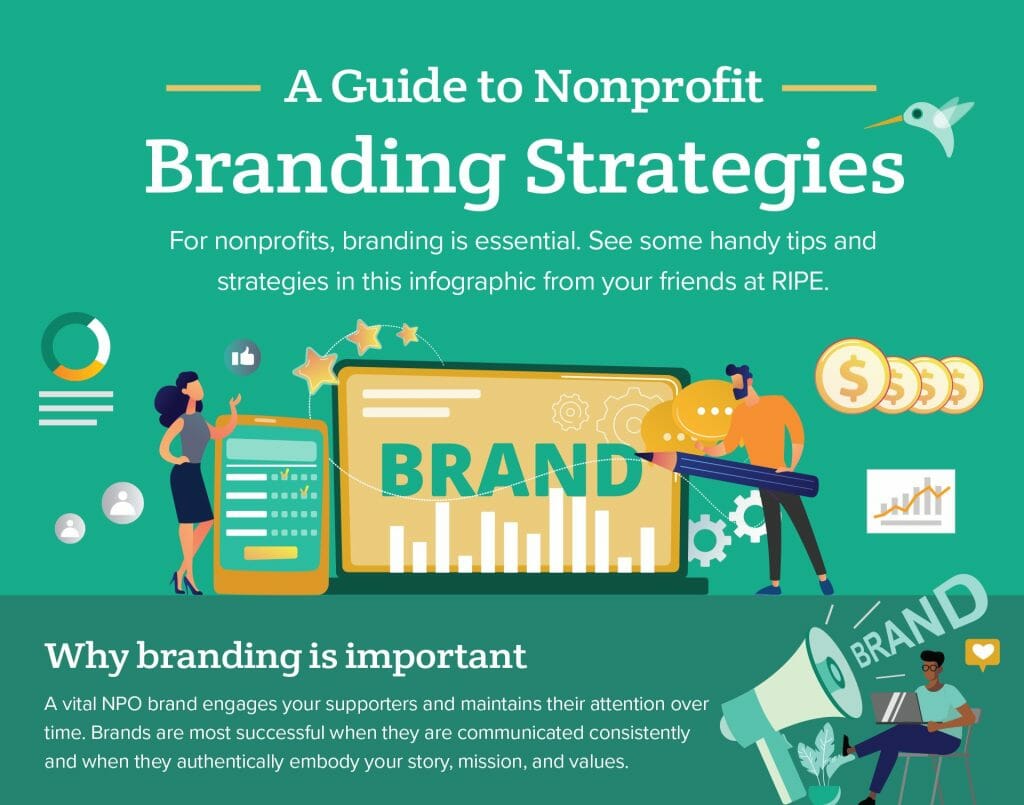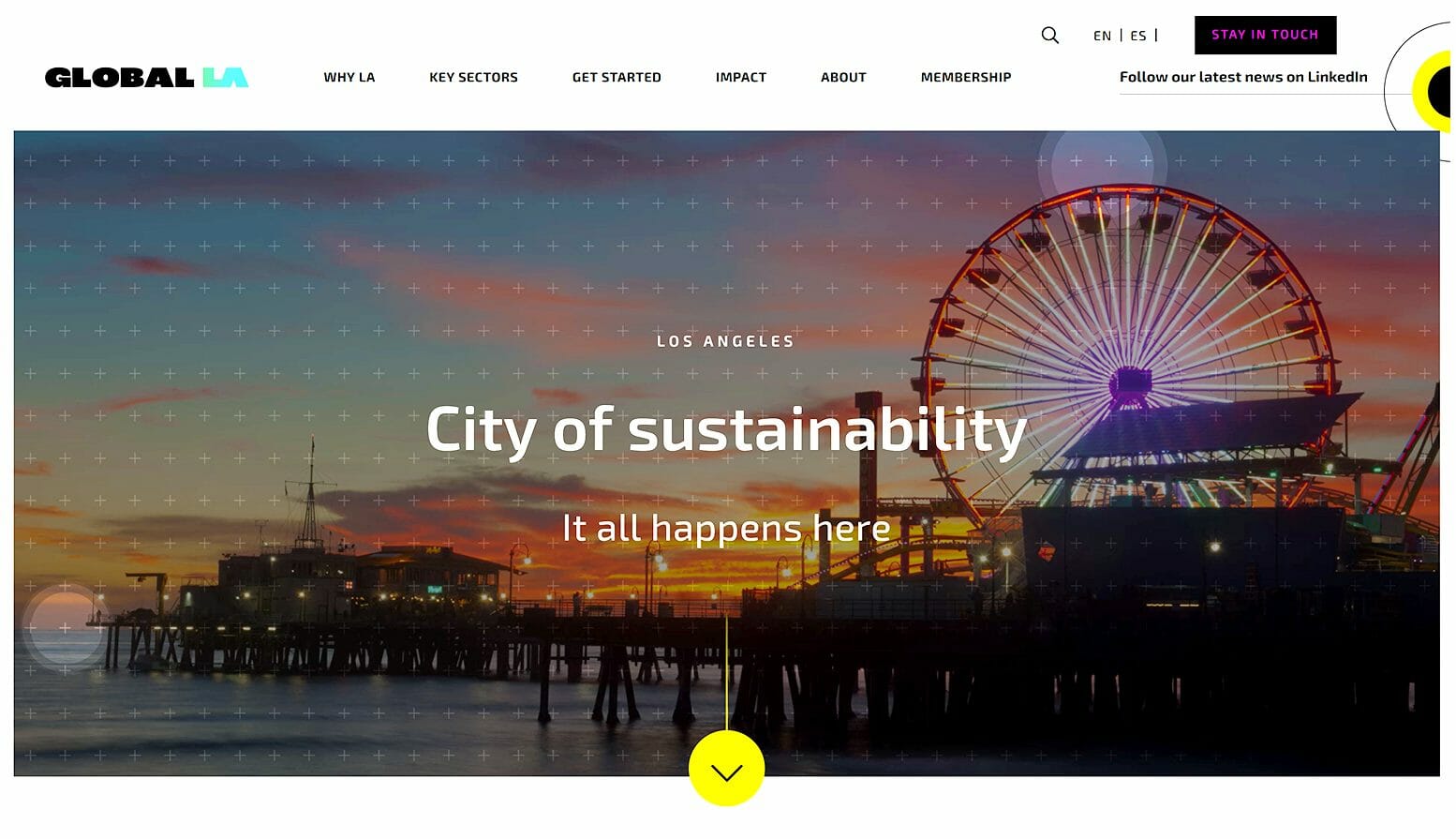25 Jan ‘23
A Guide to Nonprofit Branding Strategies
25 Jan ‘23
In: Nonprofit Resources, / By: Ripe Admin
Branding is essential to the success of any business. But for not-for-profit organizations, it is crucial.
Roughly 1.5 million non-profits are operating in America. To be successful, nonprofit branding needs to be eye-catching, relatable, and unique. Organizations must develop trust with their audience.
So how should a not-for-profit use branding to bolster funding and grow its audience?
This article will share tips and strategies for nonprofit branding. This will help organizations share their mission and values with a growing community.
Click to chat with us about Branding ►
Nonprofit Branding and Marketing
First, you must understand the difference between branding and marketing.
Marketing capture’s the attention of an audience. It should be eye-catching. It should resonate with your target audience.
Branding works to maintain that attention. It shares an organization’s story, mission, and values.
Organizations use branding to reach donors and community members. Successful branding is consistent. It should be immediately recognizable.
Branding for Nonprofits
Branding for nonprofit organizations is different than that of for-profit organizations.
Other organizations operate to make money. But nonprofit organizations focus on their mission and values. Their branding exists to promote a social cause.
The messages and values shared in their branding help gain support for their mission. It should also appeal to community partners and donors. Branding is also used to promote services.
Successful branding builds trust with audiences.
Understanding Your Audience
Before building branding strategies, organizations need to determine their target audience. Think about the kind of people you want your messaging to reach.
What age are they? What kind of jobs do they do? What kind of messaging might resonate with them?
Once an organization determines who its target audience is, the next step is to figure out how and where to find them.
Demographics
Organizations can begin researching their target demographic.
When using social media, organizations can study online insights. Nonprofits hold focus groups. They also conduct data research to learn more about their target demographic.
Sending out a membership survey is another great way to understand your audience.
Once you understand your audience, you can use your branding to reach them. Create an aesthetic and messaging that resonates with them.
Finding Your Market Fit
Next, organizations need to determine where they fit within the market. This is true, even for nonprofit organizations.
Begin by identifying competitors. Look at the strengths and weaknesses of your competition to determine which needs are not met in the market.
Aim to provide unique services that are not currently offered. This will help your organization carve out its niche within the market.
Click to chat with us about Branding ►
Creating a Brand Identity
Consistency is key to the development of a brand identity. The mission of a nonprofit should be at the center of everything they do. This extends to their branding as well.
Before creating a brand, nonprofits should also consider the goals they are trying to accomplish with their branding.
Next, they should consider their brand’s story and layout.
Finally, it’s time to think about their branding style. Nonprofits should create an aesthetic that speaks to their values. Consider this when thinking about the elements of a brand.
When creating a branding guide, think about the following things.
The Story
The story of a nonprofit is at the core of its branding. Your story is key to building connections and gaining support.
Your story should be clear and concise. It should also be intentional. Make sure the story you tell represents your organization’s mission and values.
A great story will evoke empathy. It will help your organization reach donors and develop trust. This happens when you tell a story about someone, using emotional and sensory language, and creating a compelling narrative structure.
Tone of Voice
Nonprofit branding guides should also distinguish a tone of voice. The tone of voice should be consistent across all platforms.
The tone of voice used should reflect your organization’s personality. Determine if it will be funny or serious, sarcastic or formal.
For example, a children’s hospital foundation may use light-hearted language accessible to children as well. But a human rights organization might be more matter-of-fact in its delivery.
The tone of voice reminds your audience that your organization’s made up of real humans. It will help you grow your membership and build community connections.
Fonts
Typography plays a huge part in how to brand a nonprofit.
When selecting a font for your organization’s branding, the font must be accessible and easy to read. Use serif fonts for your headings and sans-serif fonts for the body of your text.
The font must be versatile and match the mood of your organization. For example, modern fonts are a great fit for progressive organizations. But legacy organizations may opt for something more traditional.
Use the font across all platforms, from a website to direct mail items.
Color Palette
When considering how to brand a nonprofit, choosing an effective color palette is essential.
A color palette helps set the mood of your brand. Colors evoke emotion and emotions drive decisions. Therefore, your color palette must grab the attention of your audience intentionally.
The colors in your branding should speak to your mission. For example, an environmental organization might use earth tones like green and brown. But red’s associated with passion and helps to create a sense of urgency.
Once developed, a color palette should be used consistently in all branding including logos, websites, and newsletters. Using colors consistently will help make your brand more recognizable.
Logo
Your logo should use other elements of your branding including fonts, colors, and your story to speak to what your organization does.
It should reflect your organization’s mission clearly and uniquely. A logo should include artistic elements but be easy to scale for a variety of use. It should also look impactful in black and white as well as in color.
Logos often include taglines. Taglines should be clever phrases that align with an organization’s mission and values.
A great logo will evoke a sense of emotion in your audience, often prompting them to act or take interest in your services.
Community Partners & Friends
One element that is especially important for nonprofit organizations, is their shared values. Organizations must have a set of principles and values that determine who they align with.
Community partners and friends of an organization are important to growing donorship, extending memberships, and raising awareness. But the wrong partner can be detrimental to an organization’s image.
If you align with an organization that does not have a shared sense of values, it can damage the trust in your organization, or confuse your supporters. Therefore, these values and principles should be outlined in a branding guide as well.
Branding Strategies for Nonprofit Organizations
Once a branding guide is created, nonprofit organizations can begin implementing branding strategies. In the beginning, it is best to test branding out, to see how it is resonating with your audience. Then, organizations can pivot and alter their branding elements as required.
This fine-tuning will eventually lead to a brand that is efficient and recognizable. It is important to remain consistent, applying brand elements to all areas of your organization.
Nonprofits should also review a branding strategy regularly, and make changes when they need to. This will help them stay fresh and relevant, and continue reaching their audience.
Click to chat with us about Branding ►
Here are some popular strategies used to build community with your brand.
Website
Creating a functional user-friendly website is important to the success of any non-profit.
Websites should tell the story of an organization and include information about your organization’s mission, values, and governance. Being transparent about your board, policy and initiatives will increase the trust in your organization.
It is also important to think about accessibility and how to make your content available to all.
Social Media
Social media is critical to the success of any nonprofit organization. It is important to meet your audience where they are, and your audience is likely easiest to find on social media.
Your logo and color palette should be used in display pictures, and captions in your online posts should use your organization’s tone of voice.
Using video and powerful infographics or images is a great way for nonprofits to resonate with their audience on social media.
Social media is a great place to build connections with members, donors, and community partners.
Using email lists and CRM is one of the best nonprofit branding strategies available.
Nonprofit organizations use email lists to keep their donors and members updated. Nonprofits use email to send out newsletters. Email lists are a great way to conduct surveys with members as well.
The branding guide should be used to create emails with consistent color, logos, font, and tone.
Merch
Merch is another great way branding strategy for nonprofit organizations.
By applying your branding to free merch, your organization is inviting members to wear your marketing in the community to help promote your brand.
Nonprofit Organizations Need Branding
If you are looking to increase the visibility of your nonprofit organization, it might be time to consider a rebrand. Nonprofit branding is a delicate process that requires a lot of time and thought.
But by following the strategies discussed here, you will create a brand that speaks to your organization’s story and mission.
If you are interested in building a brand for your nonprofit, we can help you get started. Contact us today to grow your brand!
















